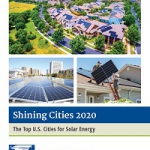Shining Cities 2020: The Top U.S. Cities for Solar Energy
Minnneapolis highlighted in new report on solar power progress
Minneapolis, MN -- Minneapolis ranked 39th for solar energy capacity per capita among the nation’s leaders. The results come from the seventh edition of Shining Cities 2020: The Top U.S. Cities for Solar Energy, a new report released today by Environment Minnesota Research & Policy Center. It is the most comprehensive survey available of installed solar capacity in major U.S. cities.
Downloads
Environment Minnesota Research and Policy Center

Minneapolis, MN — Minneapolis ranked 39th for solar energy capacity per capita among the nation’s leaders. The results come from the seventh edition of Shining Cities 2020: The Top U.S. Cities for Solar Energy, a new report released today by Environment Minnesota Research & Policy Center. It is the most comprehensive survey available of installed solar capacity in major U.S. cities.
“Minneapolis has made a lot of progress on solar,” said Tim Schaefer, state director with Environment Minnesota Research & Policy Center. “Minneapolis’ leadership on solar has provided many residents with clean, renewable power, but there’s still much more the City can do to make it affordable, efficient, and universal. That said, the progress of the past year is still worth highlighting, especially considering the current slowdown in solar development due to COVID-19.”
Beyond the findings in Minnesota, the report examined national solar power in major cities over the past seven years. The analysis found that of the 57 cities surveyed in all seven editions of this report, almost 90 percent more than doubled their total installed solar PV capacity between 2013 and 2019.
Overall, this year’s Shining Cities survey ranked 70 of America’s major cities by solar energy capacity. Honolulu placed first overall for solar energy capacity per capita, while Los Angeles finished No. 1 in total solar energy capacity installed. Leaders in per capita solar capacity region were: Honolulu in the Pacific region; Las Vegas in the Mountain region; Indianapolis in the North Central region; San Antonio in the South Central region; Jacksonville, Fla., in the South Atlantic region; and Burlington, Vt., in the Northeast region.
These numbers show tremendous progress, but the continued implementation of key policies, like those outlined in Environment Minnesota Research & Policy Center’s Renewables on the Rise report will be critical to keep clean energy growing.
“With the continued growth in solar at risk in the wake of the novel coronavirus pandemic, we must make smart policy choices in this space,” said Schaefer. “That means taking steps to build the future we need, by investing in infrastructure that advances a future powered entirely by renewable energy sources. We can and should make solar power a resource that benefits every single person in Minnesota — not just those who can already afford it.”
###
Environment Minnesota Research & Policy Center works for clean air, clean water, clean energy, wildlife and open spaces, and a livable climate. Our members across the state put grassroots support behind our research and advocacy. Environment Minnesota Research & Policy Center is part of Environment America Research & Policy Center, a national network of 29 state environmental groups.

